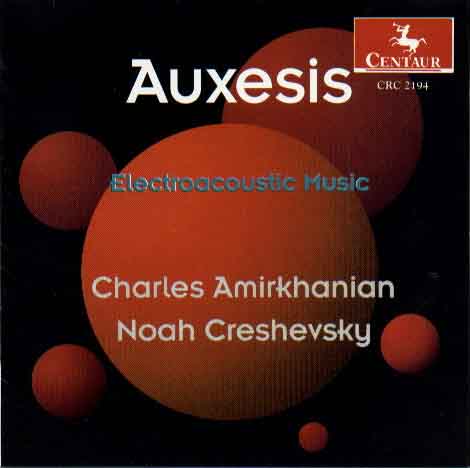|
|
“The receiver gave our a buzz of a kind
that K. had never before heard on a
telephone. It was like the hum of
countless children’s voices--hut yet not a
hum, the echo rather of voices singing at
an infinite distance--blended by sheer
impossibility into one high hut resonant
sound that vibrated on the car as if it were
trying to penetrate beyond mere hearing.”
--Frank Kafka, The Castle
Noah Creshevsky, horn in 1945 in
Rochester, New York, began musical study at
age flee at the Eastman School of Music. He
graduatcd from the State University of New
York at Buffalo, where he was a pupil of
Virgil Thomson, and studied with Nadia
Boulanger in Paris and Fontainebleau. His
master’s degree is from the Juilliard School,
where he was a pupil of Luciano Berio.
Creshevsky’s work has heen supported hy
grants and awards from the National
Endowment for the Arts, the New York State
Council on the Arts, and ASCAP. It has
been published by Alexander Broude and the
|
|
|
|
| Borrowed Time | 11:43 |
|
Borrowed Time is composed of fragments
of vocal music dating from the twelfth to
the twentieth centuries. Each sample
consists of a solitary musical event, the
duration of which is always shorter than
one second. Melodies, phrases, and
harmonic progressions were generated by
arranging and rearranging tiny hits of
embryonic musical matter.
Allusions to Middle Eastern, Asian, and
Western sacred and secular music
(including opera) seek to integrate a vast
spectrLlm of sources to form a unified
musical fabric.
Nearly all of Borrowed Time is a cappella,
and every second of it is of human origin.
Borrowed Time was composed in 1992. It
is dedicated to the memory of John Cage. |
| |
| Private Lives | 16:39 |
|
“It is good to know how not to know how
much one is knowing.”
--Stefan Wolpe
Private Lives is a suite of contrasting
movements which follow one another but
do not deliberately interact. Some of its
movements are binary, and a few are
musical portraits. Subjects include the
scholars and musicologists H. Wiley
Hitchcock and Sherman Van Solkema, the
dancer Doris Rudko, and a self-portrait.
The music which delights me most is that
which best conceals its techniques. A
resonant childhood memory is the thrill
of witnessing a magic trick without
having a hint of the maneuver behind the
illusion. Alas, the spell dissolves into
something common when an earthbound
process is unmasked for the pedestrian
thing it is.
Stravinsky was able to compose
movements which follow each other
without any apparent reason except that
they are there. In Private Lives--and in
many of my other compositions--I set Out
to link a succession of disparate moments
into something that is whole.
Private Lives was composed between
October 1992 and April 1993. It is
dedicated to H. Wiley Hitchcock. |
| |
| Coup d'etat | 8:27 |
|
“A revolution is nor a dinner parry, or
writing an essay, or painting a picture, or
doing embroidery
--Mao Zedong
“All I do is speak and write, and we
already know that speaking and writing
have no influence.”
--John Cage
our Common Prayer, whose greatest
comfort is music / Which can he made
anywhere, is invisible / And does not smell.”
--W.H. Auden
Coup d’etat begins with such giddiness that
it might be music for a dinner party gone
berserk. Until the solemn ending, all its
sections are in states of perpetual ascent.
This musical uprising is the joyous
insurrection of a composer absolved of
responsibility for anything terribly
important. As does all music, Coup d’etat
celebrates the harmless innocence of sound.
And like so much other mtisic, writing,
painting, and embroidery, it absurdly seeks
to be more than such pursuits can ever he.
Coup d’etat was composed in 1993 and
1994. It is dedicated to Glenn Snell. |
| |
|
|



